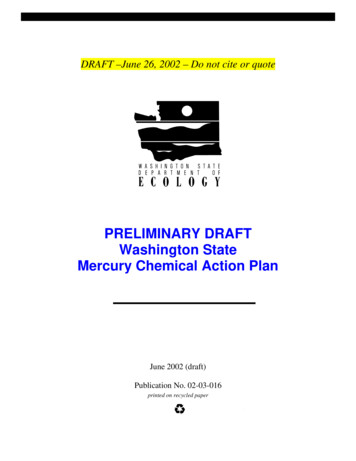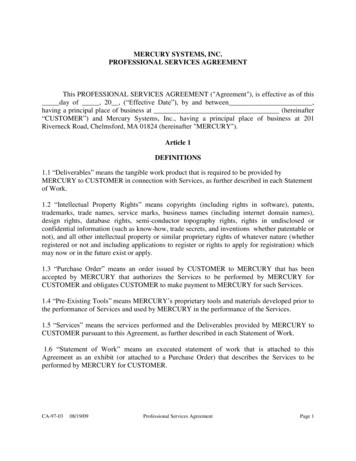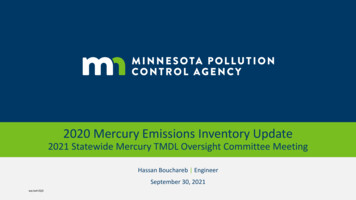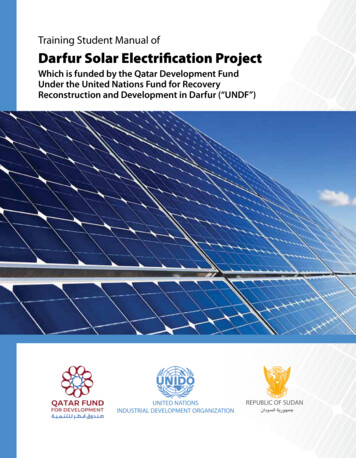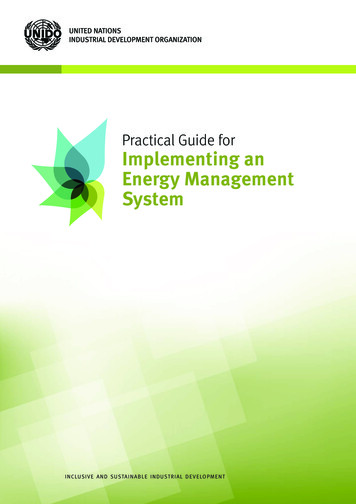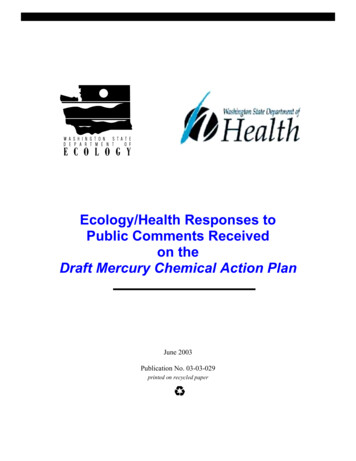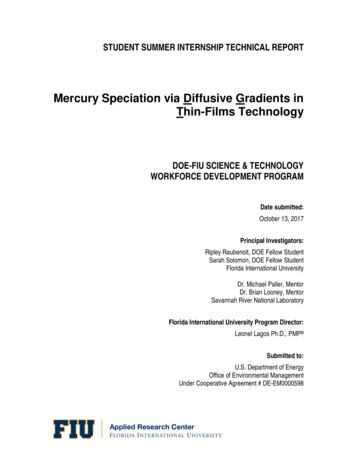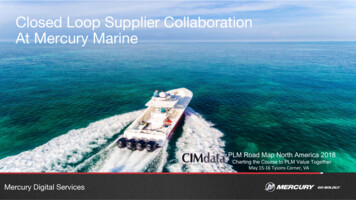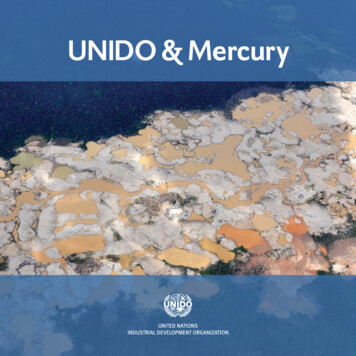
Transcription
UNIDO & Mercury
DisclaimerThis document has been produced without formal United Nations editing. The designations employed and the presentation of the material in this document do not implythe expression of any opinion whatsoever on the part of the Secretariat of the United Nations Industrial Development Organization (UNIDO) concerning the legal statusof any country, territory, city or area or of its authorities, or concerning the delimitation of its frontiers or boundaries, or its economic system or degree of development.Designations such as “developed”, “industrialized” and “developing” are intended for statistical convenience and do not necessarily express a judgment about the stagereached by a particular country or area in the development process. Mention of firm names or commercial products does not constitute an endorsement by UNIDO.Although great care has been taken to maintain the accuracy of information herein, neither UNIDO nor its Member States assume any responsibility for consequenceswhich may arise from the use of the material.This document may be freely quoted or reprinted but acknowledgement is requested.Cover photo: Carnegie Airborne Observatory of the Carnegie Institution for Science; photos on pages 4, 10, 14, 22-23, 24 and 26: Shutterstock; pages 20-21: iStockphoto
Foreword3Introduction on Mercury4The Minamata Convention7UNIDO’s Mercury Programme9UNIDO’s Project PortfolioArtisanal and Small-Scale Gold Mining10The Global Mercury Project11Burkina Faso, Mali & SenegalEcuador & PeruPhilippinesColombiaCôte d’Ivoire1315161719Mercury Waste ManagementArgentinaMongolia202123Non-Ferrous Metal Smelting24China25Minamata & Beyond27Contact28
ForewordMercury remains a major global, regional and national challenge interms of threats to human health and the environment. Over the lasttwo decades, UNIDO has successfully reduced the negative impactsof using and discharging mercury in numerous industrial applications,including in the largest user and emitter of this hazardous metal, theartisanal and small scale gold mining sector.UNIDO has also participated actively throughout the negotiations ofthe Minamata Convention on Mercury adopted in October 2013. Thetreaty is the first new global convention on environment and health inclose to a decade, and despite the lingering effects of the global financialcrisis, countries remained prepared to commit resources to combat theharmful effects of mercury.The path toward fulfilling the obligations under the convention, andtoward a more sustainable world, is long and replete with challenges.UNIDO is prepared to continue supporting countries by introducingclean technologies and policy reforms which contribute to reducing andeventually eliminating mercury contamination in all of its industrial uses.This brochure outlines the major agreements related to the new treatyand the assistance that UNIDO can provide to countries to help themmeet their legal obligation under the Minamata Convention, as well asintroduces projects which have been developed by UNIDO.Heinz LeuenbergerDirector, Environmental Management BranchUNIDO
IntroductionWhat is Mercury?Mercury is a silvery white and naturally occurringheavy metal usually found in the form of cinnabar,a mercuric sulfide ore. It is the only metal liquid atnormal conditions of temperature and pressure. Itevaporates easily into the air and is recognized asa chemical of global concern due to its long-rangetransport in the atmosphere.4Health impactsEnvironmental impactsThe notorious heavy metal is known to be a potentpoison of the human nervous system since Greekand Roman times. The exposure to mercurythrough inhalation or ingestion may pose a rangeof serious health impacts including brain andneurological damages, memory loss, skin rashes,emotional changes, tremors, kidney, heart, visionand respiratory problems, deformation of fetus andeven death.Mercury circulates between soils, water, air,sediments, and biota in various forms and oncereleased, it remains in the environment. A veryimportant ecological impact is the ability forthe organic forms of mercury to be absorbed byorganisms and magnify in concentration along foodchains, which can become extremely toxic to wildlife.
Mercury Emissions and ReleasesDue to its unique chemical properties, mercuryis used in numerous industrial applications andproducts, including in the production of chlorineand PVC and in fluorescent lamps, batteries,pesticides, cosmetics, thermometers, and dentalamalgams. Additionally, mercury is present as animpurity in many ores including, inter alia, coal,gold, copper, zinc and lead. Their extraction andfurther processing (burning or smelting) emits largequantities of mercury to the atmosphere.Artisanal and small-scale gold mining (ASGM)is responsible for approximately 37% of the globalanthropogenic mercury emissions and is the largestsource of air and water mercury pollution. UNIDOestimates that nearly 100% of the metal used in thesector is released into the environment.Low prices, easy use, high accessibility, and the lack ofknowledge about mercury and its risks are the mainreasons artisanal and small-scale miners continue touse mercury to separate gold from other materials.1960of mercury wereemitted in 2010 into the atmosphereas a result of directanthropogenic activities.tonnesUNEP, Global Mercury Assessment 2013Global anthropogenic mercury emissions in 201018%Fossil fuel combustion(power & heating)6%Metal production(ferrous & non-ferrous)24%Chlor-alkali industryWaste incineration,waste & other37%Artisanal & small-scalegold mining5%9%1%Cement productionOtherSource: Adapted from UNEP, Global Mercury Assessment 2013: Sources,Emissions, Releases and Environmental Transport, 2013.5
Photo: Associated Press6The Minamata Convention is named after the city where approximately tenthousand people were poisoned by eating fish and shellfish taken fromwaters polluted by discharges of a local factory in the 1950s.
THE CONVENTIONMinamata Convention on MercuryAfter four years of intense negotiations, a globallegally binding treaty – the Minamata Convention onMercury – was adopted by governments and openedfor signature in October 2013.The treaty aims to regulate anthropogenic emissionsand releases of mercury and its compounds in orderto protect human health and the environment.Major highlights of the Convention Ban on new mercury mines and phaseout of existing ones;Ban of production, export, and importof a range of mercury containingproducts by 2020;Phase-out or reduction ofmanufacturing processes usingmercury or mercury compounds;Control measures on air emissions andreleases to land or water;Sound management of mercury wastesand contaminated sites;National Action Plans for theartisanal and small-scale gold mining(ASGM) sector.Special concerns related to ASGM sectorThe Convention requires countries with more thaninsignificant use of mercury in ASGM operations todevelop a National Action Plan to reduce the use ofmercury or mercury compounds within three years ofthe treaty entering into force.Cooperation expected from nations in the ASGMsector: Develop strategies to prevent thediversion of mercury or mercurycompounds for use in ASGM andprocessing;Promote education, outreach andcapacity building initiatives;Promote research on sustainable nonmercury alternative practices;Provide technical and financialassistance;Create partnerships to assist in theimplementation of their commitments;Exchange information to promoteknowledge, best environmentalpractices and alternative technologiesthat are environmentally, technically,socially and economically viable.7
8
UNIDO ProgrammeUNIDO’s Mercury ProgrammeUNIDO’s targetsAs an implementing agency, UNIDO works toreduce global poverty and achieve the MillenniumDevelopment Goals through development ofsustainable and inclusive industrial growth. Toachieve this goal, UNIDO promotes Green Industryby undertaking green public investments andimplementing public policy initiatives that encourageenvironmentally responsible private investments.Based on UNIDO’s previous and existing experiencein promoting environmentally sound managementof mercury in the ASGM sector, the Organizationplays an important role as co-lead of the sectorunder the Global Mercury Partnership – the mainmechanism and technical advisory group to theMinamata Convention for the delivery of immediateactions on mercury, created by the United NationsEnvironment Programme (UNEP) in 2008.Promoting sound chemicals management is akey component of the Green Industry Initiative,to support sustainable consumption andresource efficiency, and minimize pollution andenvironmental degradation.UNIDO is also an active member of the partnershipareas relating to mercury waste, mercury in products,chlor-alkali and mercury storage. Recently, UNIDOhas expanded its technical assistance to includeother mercury industrial sectors, such as mercurywaste management, zinc smelting and chlor-alkaliproduction.UNIDO’s Mercury Programme is leading and facilitating the introductionof clean technologies and policy reform to minimize the use and dischargesof mercury. It promotes Best Available Technologies (BAT) and BestEnvironmental Practices (BEP) through awareness raising, capacity building,and technology transfer.The Programme started in 1994 with some individual projects in the Philippines,Ghana and Tanzania, however it grew in importance with the development ofthe Global Mercury Project.9
Artisanal & Small-ScaleGold Mining (ASGM)10
Global Mercury ProjectRemoval of Barriers to Introduction of Cleaner Artisanal Gold Mining and Extraction TechnologiesCountries: Brazil, Lao PDR, Indonesia, Sudan, Tanzania and ZimbabweDuration:Five years (August 2002–August 2007)Budget/donor:GEF: US 6.8 millionCo-financing: US 13 millionCo-financers:UNIDO, UNDP, and national governments (Brazil, Indonesia, Laos, Sudan, Tanzania and Zimbabwe)Main objective and key expected outputsResultsSix pilot countries located in key transboundary river/lake basins were assisted to overcome barriers to theadoption of best practices and pollution preventionmeasures to limit the mercury contamination ofinternational waters from ASGM. More than 100 local experts and miners trainedin new technologies, both on usage and how tobuild them using locally available materials; More than 30,000 miners trained, more than25,000 community members sensitized onproblems posed by the sector and their solutions; 15,000 brochures distributed, 75 media reports,nine publications in international journals,three chapters in books, two books, 37 papers inconference proceedings; and, Six international water basins benefited fromsignificant reduced pollution at project sites onthe Amazon River, the Java Sea, the MekongRiver, the Nile River, Lake Victoria and on theZambezi River.The aim of the project was to introduce cleanertechnologies, train miners, develop regulatorymechanisms and capacities within government,conduct environmental and health assessments,and build capacity in local laboratories to continuemonitoring mercury pollution after the project.11
The FAIRMINED GoldCertification Labelensures that gold hasbeen extracted andprocessed in a fair andresponsible manner,free of child labor.12
Burkina Faso,Mali & SenegalFrancophone West Africa: Improve the Health and Environmentof ASGM Communities by Reducing Mercury Emissions andPromoting Sound Chemical ManagementDuration:Three years (May 2012–May 2015)Budget/donor:FFEM: US 1,155,000GEF: US 990,000SAICM: US 220,000 (for Mali only)Co-financing: US 1,088,000Co-financers:The U.S. Department of State, European Commission,the Governments of Burkina Faso, Mali and Senegal, andUNEP and UNIDOMain objective and key expected outputsThe main objective of the project is to strengthen local and nationalcapacity to effectively manage and reduce mercury use, emissions, andexposure in ASGM communities.In addition to finalizing national strategic plans in each country,comprehensive health education and technology training programswill be developed and delivered.Lastly, the project will provide assistance for mining communities toobtain FAIRMINED Gold certification in order to address social,environmental, and economic development issues.13
14
Ecuador & PeruImplementing Integrated Measures for Minimizing MercuryReleases from Artisanal Gold MiningDuration:Three years (October 2012–September 2015)Budget/donor:GEF: US 999,900Co-financing: US 2,676,764Co-financers:UNIDO, National Geologic, Mining & Metallurgy ResearchInstitute, INIGEMM (Ecuador), the Peruvian Ministry ofEnvironment and U.S. Department of StateMain objective and key expected outputsThe project aims to reduce the use and emissions of mercury in ASGMby promoting low-mercury and mercury free technologies at localpilot sites. It will also promote innovative financial tools, support theformalization of ASGM miners and provide relevant information onthe health risks posed by mercury.A monitoring programme will be conducted in the Puyango-Tumbesriver basin which will contribute to the understanding of theenvironmental impacts posed by ASGM activities in southern Ecuadorand northern Peru.15
PhilippinesImprove the Health and Environment of Artisanal GoldMining Communities in the Philippines by Reducing MercuryEmissionsDuration:Two years (August 2013–August 2015)Budget/donor:GEF: US 550,000Co-financing: US 1,081,070Co-financers:The Department of Environment and Natural Resources (DENR),the U.S. Department of State, Ban Toxics, Dialogos, and UNIDOMain objective and key expected outputsThe project aims to promote sound chemical management of mercuryby strengthening national capacity and reducing mercury use, emissionsand exposure at pilot demonstration sites.In addition to the transfer of techniques and technology, trainingprogrammes on the health risks of mercury will also be developed anddelivered for miners.The project will seek to reduce at least 50% of mercury use, emissionsand exposure at local pilot sites by introducing low-mercury or mercuryfree technologies.16
ColombiaIntroduction of Cleaner Artisanal Gold Mining and ExtractionTechnologiesDuration:Two years (January 2011–December 2012)Budget/donor:Co-financing: US 722,010Financers:Local governments (Codechoco and Corantioquia states) and localpartnersMain objective and key expected outputsThe project promoted sound management of mercury to reduce therisks associated with mercury use in ASGM, while improving theenvironmental and economic performance of the sector.This objective was achieved by strengthening artisanal minerscapacity through trainings based on safer and cleaner practices ofgold mining.At least 10-15 millionminers are involvedworldwide, mainly inAfrica, Asia and SouthAmerica. An estimatedthree million of themare women and children(UNEP, 2012).17
18
Côte d’IvoireReducing Mercury Risks from Artisanal and Small Scale GoldMining in Côte d’IvoireDuration:Two years (August 2012–August 2014)Budget/donor:Co-financing: US 191,300Co-financers: Strategic Approach to International ChemicalsManagement (SAICM) Quick Start Programme Trust FundMain objective and key expected outputsThe project aims to reduce the risks associated with mercury use inASGM while improving the environmental and economic performanceof the sector. This objective will be achieved by building capacity withinthe country to promote sound management of mercury in ASGM, tocarry out inventories of gold mining sites and to design and implementa National Action Plan on ASGM.The obligations surrounding ASGM under the Minamata Conventionon Mercury play a key role in guiding this process.Low-mercuryand mercury freemethods are availablefor the ASGM sector,but socio-economicconditions areoften barriers to theadoption of betterpractices.19
Mercury WasteManagement20
ArgentinaPreparatory Project to Facilitate the Implementation of theLegally Binding Instrument on Mercury (Minamata Convention)in Argentina to Protect Health and the EnvironmentDuration:Two years (November 2013–November 2015)Budget/donor:GEF: US 350,000Co-financing: US 530,000Co-financers:UNIDO, Asociación Argentina de Médicos por el Medio Ambiente(AAMMA), and the Basel Convention Regional Centre for SouthAmericaMain objective and key expected outputsThe aim of the project is to set the groundwork to facilitate thefulfillment of the obligations under the Minamata Convention.The project will facilitate discussion among key stakeholders andconduct in-depth analyses of the existing legal framework and of locallyavailable Best Available Technology and Best Environmental Practicesfor the management of mercury and waste containing mercury.On this basis, a proposal for potential changes to the legal/policyframework of the country and for a small-scale pilot demonstrationproject for temporary and final disposal of mercury and wastecontaining mercury, will be prepared.21
Once used, manyproducts containingmercury end up inlandfills or incinerators,entering and pollutingwaste streams.22
MongoliaReduce Exposure of Mercury to Human Health and theEnvironment by Promoting Sound Chemical Management inMongoliaDuration:Two years (November 2013–October 2015)Budget/donor:GEF: US 600,000Co-financing: US 1,569,000Co-financers:The Mongolian Ministry of Nature and Green Development,the Mongolian Ministry of Health, the private sector (Mireco)and UNIDOMain objective and key expected outputsThe objective of the project is to develop national guidelines forenvironmentally sound management of waste containing mercury,demonstrate sound mercury remediation and stabilization techniquesat the pilot scale in mercury hot-spot areas contaminated from previousmining activities.Practical guidelines for the environmentally sound collection,transportation, treatment, and disposal of waste containing mercurywill be established and implemented at local and national levels.23
Non-FerrousMetal Smelting24
ChinaReduction of Mercury Emissions and Promotion of SoundChemical Management in Zinc Smelting OperationsDuration:Two years (September 2012–September 2014)Budget/donor:GEF TF: US 990,000Co-financing: US 4 millionCo-financers:The Foreign Economic Cooperation Office (FECO) of Ministry ofEnvironment; Zhuzhou, Shuikoushan and Shangluo zinc enterprises;Hunan, Shaanxi, and Guizhou provinces; Sino-Norwegian projects;and UNIDOMain objective and key expected outputsThe project aims to strengthen national and local capacity toeffectively manage and reduce mercury emissions from zinc smeltingoperations in neighboring communities. Best Available Technologiesand Best Environmental Practices for cleaner zinc production will bedemonstrated at two pilot sites.The project will also establish coordination and monitoring system,and propose policy reform for mercury management in the zincsmelting sector.50% of the globalanthropogenic mercuryemissions to theatmosphere comesfrom Asia. Chinaaccounts for one thirdof the global total.(UNEP, 2013)25
26
Minamata & BeyondSince 2008, and the end of the Global Mercury Project, the UNIDOMercury Programme has raised US 17.9 million, including US 6.4million of project funds directly managed by UNIDO. The programmecurrently operates in 11 countries. The Global Environment Facilityhas been the major source of funds with 25% of the total, but bilateralsupport has also been provided by the Governments of Finland andFrance.Based on its experience and comparative advantage,UNIDO will have an important and increasing role inthe coming years supporting governments in fulfillingtheir legal obligations under the Minamata Conventionon Mercury.Focus will be placed on setting national objectives and targets,complementing existing programmes, exploring innovative marketbased approaches, promoting policy reform, enhancing awareness,and promoting intervention on the ground to secure global mercuryemission reductions through technology transfer.Most of the identified issues relating to mercury are industrial bynature. UNIDO therefore, together with our financing partners,stands ready to continue and expand our assistance to the signatoriesof the Minamata Convention to ensure its rapid ratification and tocontinue demonstrating concrete results at local and global levels.27
ContactFor more information on UNIDO’s Mercury Programme, please contact:Ludovic BernaudatUNIDO Water Management UnitEnvironmental Management BranchEmail: 28
2013 — Printed in ViennaUNITED NATIONS INDUSTRIAL DEVELOPMENT ORGANIZATIONVienna International Centre, P.O. Box 300, 1400 Vienna, AustriaTelephone: 43 (0) 1 26026-0, Fax: 43 (0) 1 26926-69Email: unido@unido.org, Internet: www.unido.org
actions on mercury, created by the United Nations Environment Programme (UNEP) in 2008. UNIDO is also an active member of the partnership areas relating to mercury waste, mercury in products, chlor-alkali and mercury storage. Recently, UNIDO has expanded its technical assistance to include other mercury industrial sectors, such as mercury
